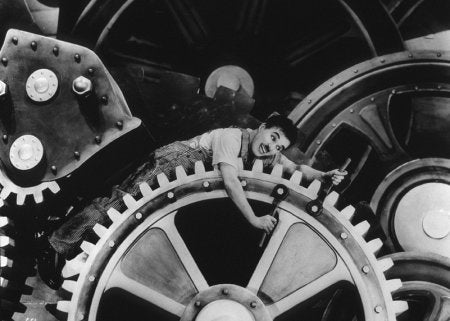 |
| Visual, non-verbal humour: the object is in an unexpected place |
Non-verbal humour, also known as visual
humour, is a form of humour and comedy that doesn't use dialogue, or uses
minimum dialogue. This form of comedy was extremely popular during the days of
the silent film. It is however, still very popular and can often be seen in
series, films and even commercials.
Many visual humour depends on the comedian
using his body as a tool. By doing funny or unexpected things with a body,
hilarity can be achieved. A technique that's often used, is the use of clothing
that doesn't fit well. Having clothes that are a size or two too large or too
small help create a character for the comedian.
Objects, as well as humans and animals, can
become funny by following one of more of the rules of visual comedy. These are:
1 – an object can become funny when it
behaves in an unexpected way
2 – an object can become funny when it is
in an unexpected place
3 – an object can become funny when it is
the wrong size
An example of number 1 is an object that
comes to life, or a human behaving like an animal (and vice versa). Number two
can for instance be a car on the roof, a banana on the head or a horse in the
kitchen presser. Number three can for instance be a giant sandwich, such as in
the Young Ones, where a woman gets squashed under a sandwich the size of a
couch. In this scene the non-verbal humour is made funnier by a verbal remark:
Neil, the vegetarian hippie, who complains the sandwich isn't vegetarian with a
complete deadpan expression.
 |
| Charlie Chaplin used non-verbal humour to great effect |
The comedian can also combine 2 or 3 of
these rules in order to achieve hilarious scenes. They should keep in mind
though, that combining 2 or 3 rules, doesn't necessarily make something 2 or 3
times as funny. If done well however, a combination of the rules can result in
absolute hilarity.
Animated comedy is able to push these rules
to the extremes. In animation it is possible to have a double-decker bus do a
somersault, have a cat grow to 500 feet in height or have objects appear or
disappear at will.
A lot of visual comedy works with slapstick
and violence. These forms of comedy are as old as comedy itself and, since they
don't require much dialogue, they were immensely popular during the silent film
era. They are these days still used in any medium you can think of. The reception
of pain by the comedian can be made funny by using a deadpan face or by means
of understatement or exaggeration.
Visual
humour can also be achieved through absurd situation. In general, the more
absurd and astonishing a situation or object becomes, the funnier it can get.
For instance a banana that bends away from the mouth when someone wants to eat
it, is funny. A banana that bends away, leaps to the ground, grows 300 feet
high and wreaks havoc is funnier, because it is absurder and it utilises rules 1
and 3 (and possibly 2, depending on its location).
In visual comedy there is one constant:
somebody (usually the comedian) suffers. Therefore the visual comedian is a
constant victim. He is however indestructible. He can take whatever the humour
throws at him but will survive in the end. Humour never dies.

Hy, I'm Ahmed Bilal there is my Youtube channel (https://youtu.be/x88NQ5LSn3g) and here is a crazy prank (Mobile Snatching prank!) out there go and must watch this but dont forget to like and subscribe our channel...
BeantwoordenVerwijderenHy, I'm Ahmed Bilal there is my Youtube channel (https://youtu.be/x88NQ5LSn3g) and here is a crazy prank (Mobile Snatching prank!) out there go and must watch this but dont forget to like and subscribe our channel...
BeantwoordenVerwijderen